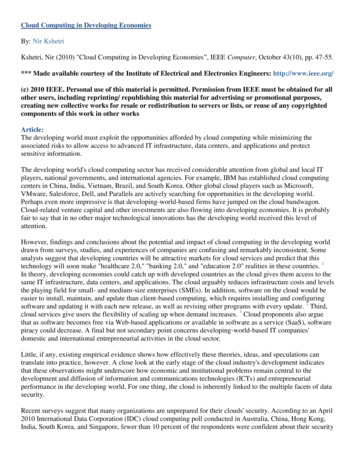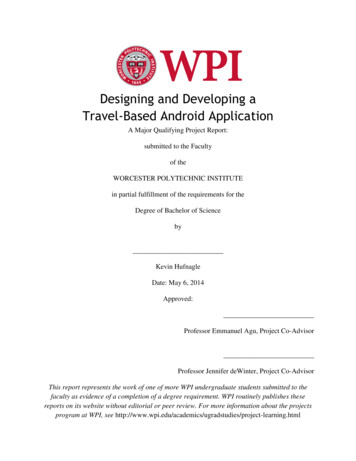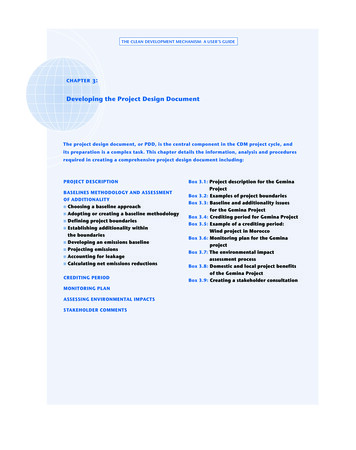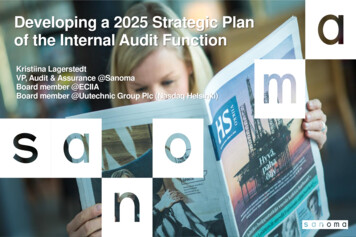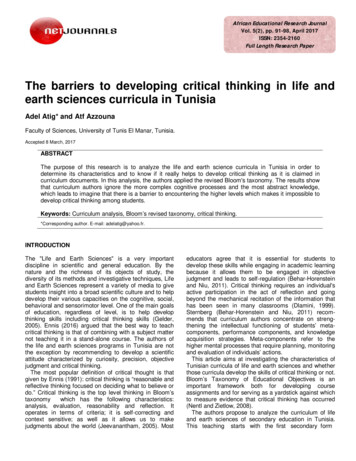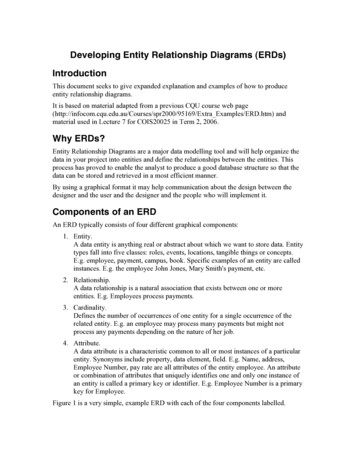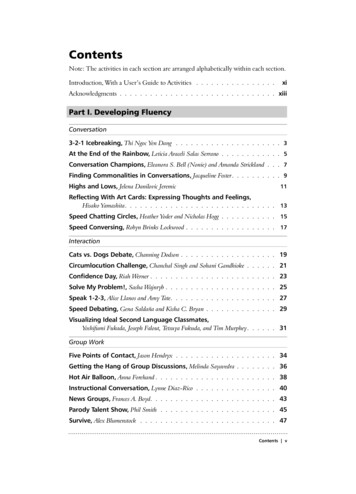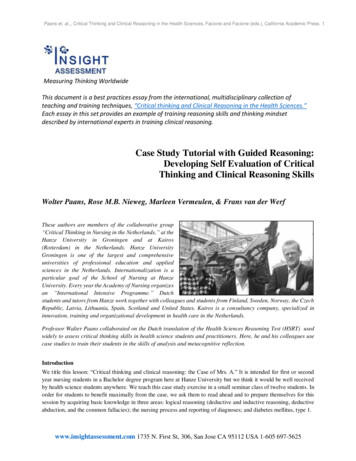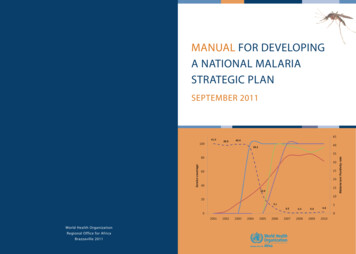
Transcription
MANUAL FOR DEVELOPINGA NATIONAL MALARIASTRATEGIC PLANSeptember 2011World Health OrganizationRegional Office for AfricaBrazzaville 2011
MANUAL FOR DEVELOPINGA NATIONAL MALARIASTRATEGIC PLANSeptember 2011
AFRO Library Cataloguing-in-Publication DataManual for developing a national malaria strategic plan1.Malaria - prevention and control2.International cooperation3.Health planning4.ManualsI. World Health Organization. Regional Office for Africa.ISBN 978 929 023 1882(NLM Classification: WC 765) WHO Regional Office for Africa, 2011Publications of the World Health Organization enjoy copyright protection in accordance with the provisionsof Protocol 2 of the Universal Copyright Convention. All rights reserved. Copies of this publication maybe obtained from the Library, WHO Regional Office for Africa, P.O. Box 6, Brazzaville, Republic of Congo(Tel: 47 241 39100; Fax: 47 241 39507; E-mail: afrobooks@afro.who.int). Requests for permission toreproduce or translate this publication, whether for sale or for non-commercial distribution, should besent to the same address.The designations employed and the presentation of the material in this publication do not imply theexpression of any opinion whatsoever on the part of the World Health Organization concerning thelegal status of any country, territory, city or area or of its authorities, or concerning the delimitation of itsfrontiers or boundaries. Dotted lines on maps represent approximate border lines for which there maynot yet be full agreement.The mention of specific companies or of certain manufacturers’ products does not imply that theyare endorsed or recommended by the World Health Organization in preference to others of a similarnature that are not mentioned. Errors and omissions excepted, the names of proprietary products aredistinguished by initial capital letters.All reasonable precautions have been taken by the World Health Organization to verify the informationcontained in this publication. However, the published material is being distributed without warranty of anykind, either express or implied. The responsibility for the interpretation and use of the material lies withthe reader. In no event shall the World Health. Organization or its Regional Office for Africa be liable fordamages arising from its use.Designed and Printed in AFRO,Republic of Congo2M anualfor developing a nationalM alaria S trategic P lan
ContentsForeword.7Abbreviations. 5Introduction.11Background.11Definition and benefits of strategic planning.12Purpose of the manual.12Structure of the manual.13Guiding Principles for Effective National MalariaStrategic Plan Development.14Country Leadership and Ownership.14Inclusive and Coordinated Partnership.14Accountability.15Evidence Based and Result Oriented.16Equity, gender and human rights.173.Priorities for the National Malaria Strategic Plan.194.Process and Steps for developing a National MalariaStrategic Plan.234.1Step 1: Organizing and preparing the planning process.254.1.14.1.2Communicate the need for a new plan.25Set up a steering committee and technical working group forthe development of the strategic plan.253M anualfor developing a nationalM alaria S trategic P lan
4.1.34.1.44.1.54.1.64.1.74.2Step 2: Situation analysis – Programme review.274.2.14.2.24.2.34.2.44.2.54.2.64.3Review the malaria epidemiology and stratification.27Review the policy, and management framework for malariacontrol in the country.28Assess progress towards achievement of national, regionaland global targets and the programme performance bythematic areas.29Conduct SWOT Analysis.29Identify strategic issues.31Define the next steps for improving programme performanceor redefining the strategic directions and priorities.31Step 3: Strategic Framework .4Select a facilitator for the strategic planning exercise.26Undertake Stakeholders analysis.26Develop work plan for the strategic planning process.26Request for technical assistance.26Gather information for the situation analysis andprogramme review.27Develop or review the vision of the programme.31Develop or review the programme mission.31Develop or review the programme guiding principles and values.31Set the strategic directions and policy priorities.32Develop goal (s) for the strategic plan period.32Define SMART objectives and targets.32Describe interventions and implementation strategiesto be used to achieve the set objectives.34Step 4: Setting the performance framework.344.4.14.4.2Define impact and outcome indicators.34Define baseline and targets for the indicators.354M anualfor developing a nationalM alaria S trategic P lan
4.4.34.4.44.4.54.4.64.5Step 5: Drafting an Action plan.354.5.14.5.24.5.34.5.44.5.54.6Conduct programmatic gap analysis and identify the changesneeded to fulfill the new goals and objectives.37Develop main activities for each intervention.38Describe programme management and partners coordination.38Estimate timelines.38Costing of the plan.39Step 6: Finalizing and adopting the strategic plan.394.6.14.6.24.6.34.6.44.7Define sources of data for the indicators.35Define data collection methods.35Define frequency of reporting on the indicators.35Define responsible entities for each indicator.35Share the document for review.39Hold technical stakeholders meeting to review the strategic plan.39Edit the Strategic Plan.39Organize stakeholders meeting to adopt the revised strategic plan.39Step 7: Strategic plan dissemination and resource mobilization.404.7.14.7.24.7.3Develop a resource mobilization strategy.40Produce a summary of the strategic plan.40Launch the strategic plan and organize a round table for resource mobilization.405.Outline and proposed content of a national malariastrategic plan.416Bibliography.515M anualfor developing a nationalM alaria S trategic P lan
Annexes1.Pre-condition for planning malaria pre-eliminationand elimination.522.Example of national Malaria Control Programme Structure.543.Schematic view of the main steps in malaria strategic plan . . 54development.554.Definition of terms.575.Templates for implementation plan and action plan.566.Roll back Malaria Target for 2015 .597.Actions proposed by Ministers of Heath for accelerated malaria controltowards its elimination in the African Region (RC 59, Kigali, September 2009) .616M anualfor developing a nationalM alaria S trategic P lan
ForewordSince the launch of Roll Back Malaria partnership in 1998, WHO and partners have been supporting countries todevelop national strategic plans that guide the fight against malaria. The period 2000-2010 gave an opportunityto the endemic countries to develop and implement the first and second generation malaria strategic plans thatled to significant progress in scaling up cost-effective interventions and reducing the malaria cases and deathsin many countries with the increased resources available. Currently, countries are working on third generationstrategic plans in line with the Millennium development goals and Roll back Malaria targets.Despite the progress made, endemic countries and their respective partners identified the need to have commontools to assess malaria programme performance and to develop national strategic plans. An important part ofWHO’s mandate is to support countries by providing such tools. In this regard, WHO worked with the malariapartners in an inclusive way to develop a manual for malaria programme performance review and a manual fornational malaria strategic plan development.The national malaria strategic plan development manual provides orientation on the guiding principles fornational malaria strategic plan development; priorities to achieve malaria control pre-elimination, and eliminationobjectives; the process for developing a strategic plan and the outline and content of a malaria strategic plandocument.Prior to publication and dissemination, the manual was tested in some countries. The authors receivedcontributions and comments at various stages from experts working in endemic countries and from partnersduring four Roll back Malaria subregional network meetings and the final review meeting organized in Accra inNovember 2010.7M anualfor developing a nationalM alaria S trategic P lan
AbbreviationsACTArtemisinin-based Combination TherapyAFROWHO regional office for AfricaALMAAfrican Leaders Malaria AllianceCCMCountry coordination MechanismCHAIClinton Health Access InitiativeDFIDDepartment for International DevelopmentDHSDemographic Health SurveyGDP Gross Domestic ProductGFATM Global Fund to fight AIDS, Tuberculosis and malariaGIS Geographic Information SystemGMAP Global Malaria Action PlanHDIHuman Development indicatorsHISHealth Information SystemIPTiIntermittent Preventive Treatment for infantIPTpIntermittent Preventive Treatment for pregnant womenIRSIndoor residual SprayingISTInter-country Support teamITNInsecticide Treated NetsLLINLong Lasting Insecticidal NetsMACEPAMalaria control and Evaluation Partnership in AfricaMDGMillennium Development GoalMICSMultiple Cluster indicators SurveyMISMalaria Indicators SurveyNMCPNational malaria Control ProgrammeMOHMinistry of HeathMPRMalaria Programme Performance ReviewMSPMalaria Strategic Plan8M anualfor developing a nationalM alaria S trategic P lan
M&EMTRMonitoring and EvaluationMid-Term ReviewPMI Presidential Malaria InitiativePSMProcurement and Supply ManagementRBMRoll Back MalariaRDT Rapid Diagnosis TestSDA Service Delivery AreaSPR Slide Positivity RateSWOT Strengths, Weaknesses, Opportunities and ThreatsUNICEF United National Children’s Emergency FundUNSE U N Secretary General Special Envoy for malaria officeWHO World Health OrganizationWHA World Health Assembly9M anualfor developing a nationalM alaria S trategic P lan
AcknowledgementsThe manual was developed by a WHO technical group consisting of Socé Fall (lead author), Khoti Gausi, NathanBakyaita, Akpaka Kalu, Charles Paluku and Shiva Murugasampillay with valuable advice from James Banda,(RBM), Georges Ki-zerbo (WHO AFRO), Robert Newman (WHO HQ) and Jean Baptiste Roungou (WHO AFRO).The group would like to thank the RBM Secretariat and the RBM Harmonization Working Group in particular forfinancial support and co-sponsorship of consultations with all national malaria programmes in the African Regionduring the sub-regional network meetings and the review meeting held in Accra, Ghana in November 2010.This manual was reviewed and amended by the following experts from partner institutions and ministry of healthwho also participated in different malaria programme reviews that advised on its development.Robert Agyarko (ALMA), Abdullah Ali (NMCP Zanzibar), Suprotik Basu (UNSE, New York), Hana Bilak(MACEPA),Valentina Buj (UNICEF, New York), Richard Carr (RBM), Noel Chisaka (World Bank, New York), TiemanDiarra (WHO AFRO), Mame Birame diouf (NMCP Senegal) Wilfried Dodoli (WHO Malawi), Duncan Earl (MACEPA),Etienne Minkoulou (WHO), Dina Gbenou (WHO Benin), Abdou Salam Gueye (PMI), Habi Gado (WHO Niger), YacoubaImorou (NMCP Benin), Elizabeth Juma (NMCP Kenya), Corine Karema (NMCP Rwanda), Simon Kunene (NMCP,Swaziland) Marcel Lama (GFATM), Paul Libiszowski (MACEPA), Boniface Maket (MACEPA), Kudzai Makomva(CHAI), Fred Masaninga (WHO Zambia), Abani Mazoo (NMCP Niger), Eunice Misiani (NMCP South Africa), KentseMoakofhi (WHO Botswana), Patrick Moonasar (NMCP South Africa), Tjantililli Mosweunyane (NMCP Botswana),Basimike Mulenda (WHO IST Gabon), Dubulao Moyo (NMCP Malawi), José Nkuni (WHO, Geneva), Josephine Namboze(WHO IST, Harare), Tej Nuthulahanti (CHAI), Peter Olumese (WHO, Geneva) Melanie Renshaw (ALMA) ClaudeRwagacondo (RBM), Bakary Sambou (WHO Senegal), Moussa Thior (NMCP Senegal), Desta Tiruneh (WHO Namibia),Stephane Tohon (WHO IST Burkina Faso), Luciano Tuseo (WHO Madagascar), Elena Trajkovska (UNICEF, NewYork), Petrina Uusiku (NMCP Namibia), Thinley Yangzom (NMCP Bhutan), Jinkou Zhao (GFATM) The manual wasalso reviewed in the WHO Regional office for Africa in the Disease Prevention and Control Cluster (DPC).Finally, we would like to thank all the national malaria programmes in the WHO African Region that have workedtirelessly to Roll Back Malaria and whose experiences have informed the design and content of this manual.10 M anual fordeveloping a nationalM alaria S trategic P lan
1. Introduction1.1 BackgroundMalaria continues to be a major cause of illness and death in the African region despite the encouraging progressmade by many countries during the past years. The World Malaria Report 2010 estimated that 80% of the 225million cases and 90% of the 781 000 deaths occur in the African Region. In 1998, the Roll Back Malaria (RBM)initiative was launched to advocate for and coordinate malaria control efforts aimed at halving the malaria burdenby 2010. Subsequently, countries were supported by WHO and the development partners to conduct situationanalyses and develop their first generation malaria strategic plans. Around 2005, the second generation strategicplans were developed. Throughout 2010 and 2011, many countries are conducting programme performancereviews and developling 3rd generation malaria strategic plans.While the first generation plans aimed at increasing the coverage of key malaria interventions amongvulnerable populations (mostly children under five and pregnant women), most second generation plansbridged the transition from scaling-up to universal coverage (access by all populations at risk of malaria toall malaria-control interventions) in order to ensure impact on malaria morbidity and mortality. Throughoutthe African region, efforts by national authorities and their partners have led to increased coverage of antimalarial interventions, mostly LLINs, and hence the resulting impact. Changes in treatment and diagnosticpolicies have also helped countries to achieve improved outcomes for those needing treatment. In 2009 datafrom health facilities in 12 countries1 showed that morbidity and mortality due to malaria had decreased bymore than 50%. However, many countries still face challenges – particularly in implementing comprehensivepolicies and strategies for att
strategic plans in line with the Millennium development goals and Roll back Malaria targets. Despite the progress made, endemic countries and their respective partners identified the need to have common tools to assess malaria programme performance

